Yuan-Fang Li
Knowledge-Aligned Counterfactual-Enhancement Diffusion Perception for Unsupervised Cross-Domain Visual Emotion Recognition
May 26, 2025Abstract:Visual Emotion Recognition (VER) is a critical yet challenging task aimed at inferring emotional states of individuals based on visual cues. However, existing works focus on single domains, e.g., realistic images or stickers, limiting VER models' cross-domain generalizability. To fill this gap, we introduce an Unsupervised Cross-Domain Visual Emotion Recognition (UCDVER) task, which aims to generalize visual emotion recognition from the source domain (e.g., realistic images) to the low-resource target domain (e.g., stickers) in an unsupervised manner. Compared to the conventional unsupervised domain adaptation problems, UCDVER presents two key challenges: a significant emotional expression variability and an affective distribution shift. To mitigate these issues, we propose the Knowledge-aligned Counterfactual-enhancement Diffusion Perception (KCDP) framework. Specifically, KCDP leverages a VLM to align emotional representations in a shared knowledge space and guides diffusion models for improved visual affective perception. Furthermore, a Counterfactual-Enhanced Language-image Emotional Alignment (CLIEA) method generates high-quality pseudo-labels for the target domain. Extensive experiments demonstrate that our model surpasses SOTA models in both perceptibility and generalization, e.g., gaining 12% improvements over the SOTA VER model TGCA-PVT. The project page is at https://yinwen2019.github.io/ucdver.
Distill-C: Enhanced NL2SQL via Distilled Customization with LLMs
Mar 30, 2025Abstract:The growing adoption of large language models (LLMs) in business applications has amplified interest in Natural Language to SQL (NL2SQL) solutions, in which there is competing demand for high performance and efficiency. Domain- and customer-specific requirements further complicate the problem. To address this conundrum, we introduce Distill-C, a distilled customization framework tailored for NL2SQL tasks. Distill-C utilizes large teacher LLMs to produce high-quality synthetic data through a robust and scalable pipeline. Finetuning smaller and open-source LLMs on this synthesized data enables them to rival or outperform teacher models an order of magnitude larger. Evaluated on multiple challenging benchmarks, Distill-C achieves an average improvement of 36% in execution accuracy compared to the base models from three distinct LLM families. Additionally, on three internal customer benchmarks, Distill-C demonstrates a 22.6% performance improvement over the base models. Our results demonstrate that Distill-C is an effective, high-performing and generalizable approach for deploying lightweight yet powerful NL2SQL models, delivering exceptional accuracies while maintaining low computational cost.
SQLong: Enhanced NL2SQL for Longer Contexts with LLMs
Feb 23, 2025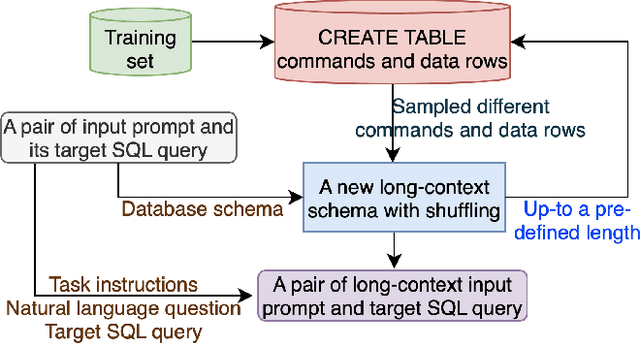
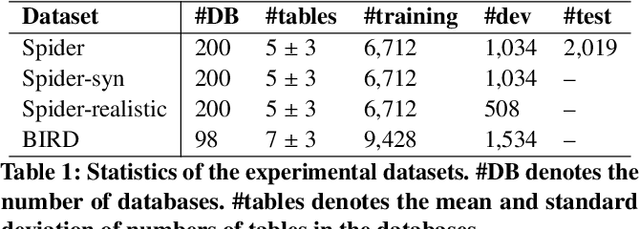
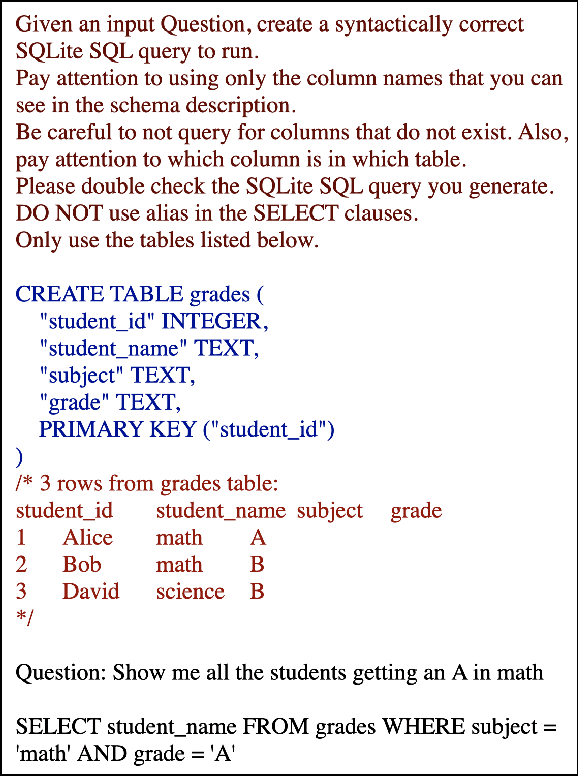

Abstract:Open-weight large language models (LLMs) have significantly advanced performance in the Natural Language to SQL (NL2SQL) task. However, their effectiveness diminishes when dealing with large database schemas, as the context length increases. To address this limitation, we present SQLong, a novel and efficient data augmentation framework designed to enhance LLM performance in long-context scenarios for the NL2SQL task. SQLong generates augmented datasets by extending existing database schemas with additional synthetic CREATE TABLE commands and corresponding data rows, sampled from diverse schemas in the training data. This approach effectively simulates long-context scenarios during finetuning and evaluation. Through experiments on the Spider and BIRD datasets, we demonstrate that LLMs finetuned with SQLong-augmented data significantly outperform those trained on standard datasets. These imply SQLong's practical implementation and its impact on improving NL2SQL capabilities in real-world settings with complex database schemas.
A Unified Hyperparameter Optimization Pipeline for Transformer-Based Time Series Forecasting Models
Jan 02, 2025



Abstract:Transformer-based models for time series forecasting (TSF) have attracted significant attention in recent years due to their effectiveness and versatility. However, these models often require extensive hyperparameter optimization (HPO) to achieve the best possible performance, and a unified pipeline for HPO in transformer-based TSF remains lacking. In this paper, we present one such pipeline and conduct extensive experiments on several state-of-the-art (SOTA) transformer-based TSF models. These experiments are conducted on standard benchmark datasets to evaluate and compare the performance of different models, generating practical insights and examples. Our pipeline is generalizable beyond transformer-based architectures and can be applied to other SOTA models, such as Mamba and TimeMixer, as demonstrated in our experiments. The goal of this work is to provide valuable guidance to both industry practitioners and academic researchers in efficiently identifying optimal hyperparameters suited to their specific domain applications. The code and complete experimental results are available on GitHub.
Scalable and Effective Negative Sample Generation for Hyperedge Prediction
Nov 19, 2024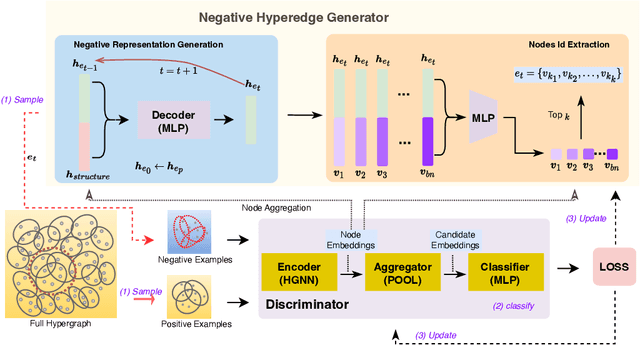
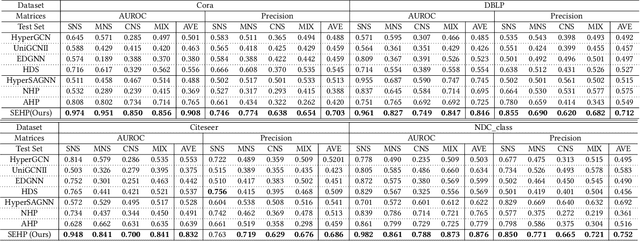
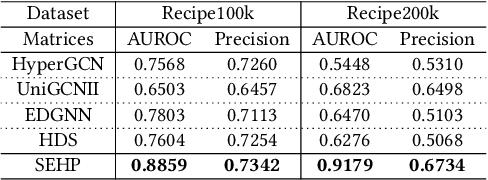
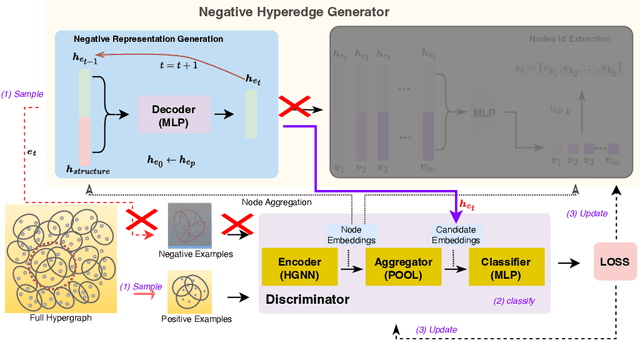
Abstract:Hyperedge prediction is crucial in hypergraph analysis for understanding complex multi-entity interactions in various web-based applications, including social networks and e-commerce systems. Traditional methods often face difficulties in generating high-quality negative samples due to the imbalance between positive and negative instances. To address this, we present the Scalable and Effective Negative Sample Generation for Hyperedge Prediction (SEHP) framework, which utilizes diffusion models to tackle these challenges. SEHP employs a boundary-aware loss function that iteratively refines negative samples, moving them closer to decision boundaries to improve classification performance. SEHP samples positive instances to form sub-hypergraphs for scalable batch processing. By using structural information from sub-hypergraphs as conditions within the diffusion process, SEHP effectively captures global patterns. To enhance efficiency, our approach operates directly in latent space, avoiding the need for discrete ID generation and resulting in significant speed improvements while preserving accuracy. Extensive experiments show that SEHP outperforms existing methods in accuracy, efficiency, and scalability, representing a substantial advancement in hyperedge prediction techniques. Our code is available here.
An Empirical Analysis on Spatial Reasoning Capabilities of Large Multimodal Models
Nov 09, 2024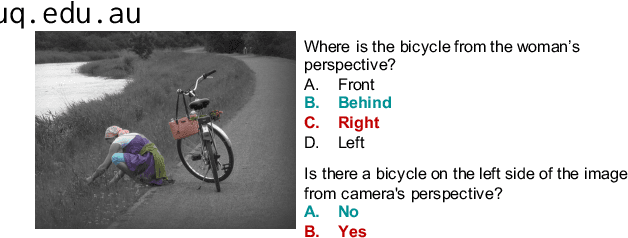

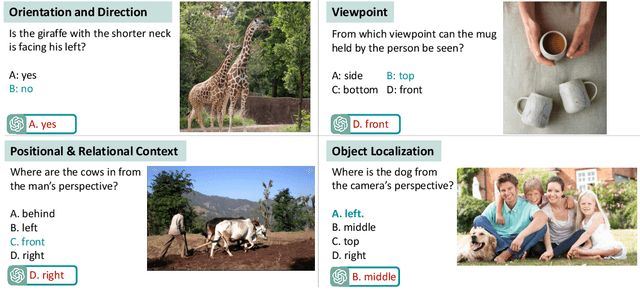
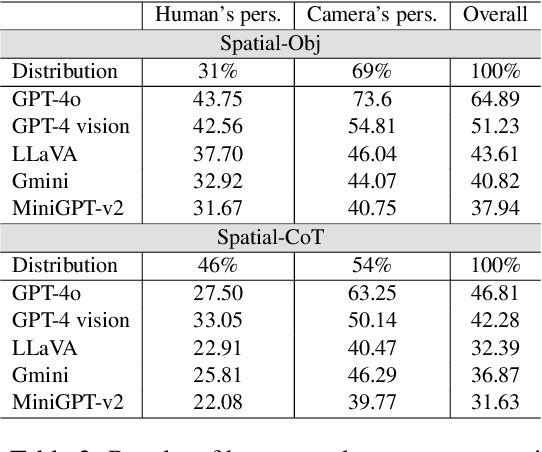
Abstract:Large Multimodal Models (LMMs) have achieved strong performance across a range of vision and language tasks. However, their spatial reasoning capabilities are under-investigated. In this paper, we construct a novel VQA dataset, Spatial-MM, to comprehensively study LMMs' spatial understanding and reasoning capabilities. Our analyses on object-relationship and multi-hop reasoning reveal several important findings. Firstly, bounding boxes and scene graphs, even synthetic ones, can significantly enhance LMMs' spatial reasoning. Secondly, LMMs struggle more with questions posed from the human perspective than the camera perspective about the image. Thirdly, chain of thought (CoT) prompting does not improve model performance on complex multi-hop questions involving spatial relations. % Moreover, spatial reasoning steps are much less accurate than non-spatial ones across MLLMs. Lastly, our perturbation analysis on GQA-spatial reveals that LMMs are much stronger at basic object detection than complex spatial reasoning. We believe our benchmark dataset and in-depth analyses can spark further research on LMMs spatial reasoning. Spatial-MM benchmark is available at: https://github.com/FatemehShiri/Spatial-MM
Towards Effective Data-Free Knowledge Distillation via Diverse Diffusion Augmentation
Oct 23, 2024Abstract:Data-free knowledge distillation (DFKD) has emerged as a pivotal technique in the domain of model compression, substantially reducing the dependency on the original training data. Nonetheless, conventional DFKD methods that employ synthesized training data are prone to the limitations of inadequate diversity and discrepancies in distribution between the synthesized and original datasets. To address these challenges, this paper introduces an innovative approach to DFKD through diverse diffusion augmentation (DDA). Specifically, we revise the paradigm of common data synthesis in DFKD to a composite process through leveraging diffusion models subsequent to data synthesis for self-supervised augmentation, which generates a spectrum of data samples with similar distributions while retaining controlled variations. Furthermore, to mitigate excessive deviation in the embedding space, we introduce an image filtering technique grounded in cosine similarity to maintain fidelity during the knowledge distillation process. Comprehensive experiments conducted on CIFAR-10, CIFAR-100, and Tiny-ImageNet datasets showcase the superior performance of our method across various teacher-student network configurations, outperforming the contemporary state-of-the-art DFKD methods. Code will be available at:https://github.com/SLGSP/DDA.
Scalable Frame-based Construction of Sociocultural NormBases for Socially-Aware Dialogues
Oct 04, 2024


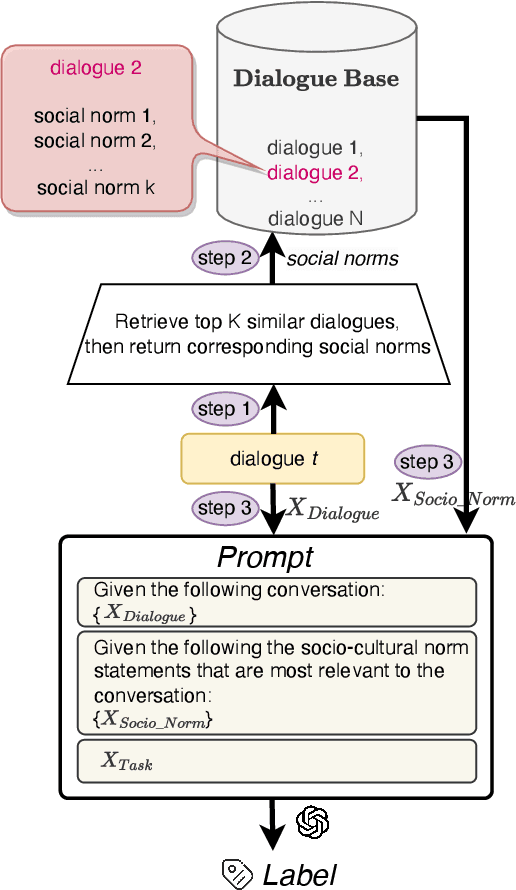
Abstract:Sociocultural norms serve as guiding principles for personal conduct in social interactions, emphasizing respect, cooperation, and appropriate behavior, which is able to benefit tasks including conversational information retrieval, contextual information retrieval and retrieval-enhanced machine learning. We propose a scalable approach for constructing a Sociocultural Norm (SCN) Base using Large Language Models (LLMs) for socially aware dialogues. We construct a comprehensive and publicly accessible Chinese Sociocultural NormBase. Our approach utilizes socially aware dialogues, enriched with contextual frames, as the primary data source to constrain the generating process and reduce the hallucinations. This enables extracting of high-quality and nuanced natural-language norm statements, leveraging the pragmatic implications of utterances with respect to the situation. As real dialogue annotated with gold frames are not readily available, we propose using synthetic data. Our empirical results show: (i) the quality of the SCNs derived from synthetic data is comparable to that from real dialogues annotated with gold frames, and (ii) the quality of the SCNs extracted from real data, annotated with either silver (predicted) or gold frames, surpasses that without the frame annotations. We further show the effectiveness of the extracted SCNs in a RAG-based (Retrieval-Augmented Generation) model to reason about multiple downstream dialogue tasks.
* 17 pages
NEUSIS: A Compositional Neuro-Symbolic Framework for Autonomous Perception, Reasoning, and Planning in Complex UAV Search Missions
Sep 16, 2024



Abstract:This paper addresses the problem of autonomous UAV search missions, where a UAV must locate specific Entities of Interest (EOIs) within a time limit, based on brief descriptions in large, hazard-prone environments with keep-out zones. The UAV must perceive, reason, and make decisions with limited and uncertain information. We propose NEUSIS, a compositional neuro-symbolic system designed for interpretable UAV search and navigation in realistic scenarios. NEUSIS integrates neuro-symbolic visual perception, reasoning, and grounding (GRiD) to process raw sensory inputs, maintains a probabilistic world model for environment representation, and uses a hierarchical planning component (SNaC) for efficient path planning. Experimental results from simulated urban search missions using AirSim and Unreal Engine show that NEUSIS outperforms a state-of-the-art (SOTA) vision-language model and a SOTA search planning model in success rate, search efficiency, and 3D localization. These results demonstrate the effectiveness of our compositional neuro-symbolic approach in handling complex, real-world scenarios, making it a promising solution for autonomous UAV systems in search missions.
A Multi-Modal Deep Learning Based Approach for House Price Prediction
Sep 09, 2024

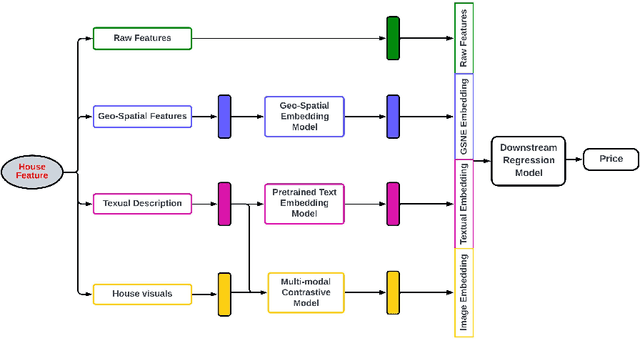

Abstract:Accurate prediction of house price, a vital aspect of the residential real estate sector, is of substantial interest for a wide range of stakeholders. However, predicting house prices is a complex task due to the significant variability influenced by factors such as house features, location, neighborhood, and many others. Despite numerous attempts utilizing a wide array of algorithms, including recent deep learning techniques, to predict house prices accurately, existing approaches have fallen short of considering a wide range of factors such as textual and visual features. This paper addresses this gap by comprehensively incorporating attributes, such as features, textual descriptions, geo-spatial neighborhood, and house images, typically showcased in real estate listings in a house price prediction system. Specifically, we propose a multi-modal deep learning approach that leverages different types of data to learn more accurate representation of the house. In particular, we learn a joint embedding of raw house attributes, geo-spatial neighborhood, and most importantly from textual description and images representing the house; and finally use a downstream regression model to predict the house price from this jointly learned embedding vector. Our experimental results with a real-world dataset show that the text embedding of the house advertisement description and image embedding of the house pictures in addition to raw attributes and geo-spatial embedding, can significantly improve the house price prediction accuracy. The relevant source code and dataset are publicly accessible at the following URL: https://github.com/4P0N/mhpp
 Add to Chrome
Add to Chrome Add to Firefox
Add to Firefox Add to Edge
Add to Edge